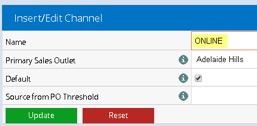On Boarding Information
Thank you for purchasing the Retail Express Connector. Please forward your E-Commerce login as requested in the setup email. If you have any issues creating E-Commerce logins please contact support@translatorhq.com.au directly.
Below is a quick summary of the key information to begin the synchronisation project.
For further detailed information please review Onboarding Details.
Linking Systems
Linking the two systems together requires unique matching SKU’s and the following items setup correctly in Retail Express:
[caption id="attachment_711" align="alignnone" width="267"] Source Group[/caption]
Source Group[/caption][caption id="attachment_710" align="aligncenter" width="257"]
 Sales Channel[/caption]
Sales Channel[/caption][caption id="attachment_709" align="alignnone" width="194"]
 Sales Channel ID[/caption]
Sales Channel ID[/caption]
Once the Source Group and Sales Channels are setup, each individual product needs to be marked as "Export to Web Service" within Retail Express as follows:
[caption id="" align="aligncenter" width="285"] Export to Web[/caption]
Export to Web[/caption]For Multiple products, it will be much quicker to do a mass download, to Excel, set the Sales Channel and "Export to WebService" columns on each item (as shown below) and re-import to Retail Express.

How the Systems Are Synchronised
The Translator application synchronises information between your Retail Express POS system and your E-Commerce site. Each system is accessed separately (through their API’s) and a number of synchronisation procedures setup to update and maintain the products’ prices, selected details and inventory levels.

It is very important to understand the concept of the Retail Express System being the “Master” holder of the truth, and the E-commerce site receives product information.
Orders from the E-Commerce site will be shipped back to Retail Express to keep both system’s quantity levels synchronised
In order for the two systems to communicate, all products must have identical SKU’s in both systems as a unique key. When preparing for an integration, if the E-Commerce site already has products, they will be checked to see if the two systems have matching SKU’s and can actually be synchronised. If they aren’t then a process to correct this needs to be undertaken before anything can be linked.
With the SKU’s setup as the unique identifier, the systems are bound together as one.
- Supplier SKU’s in Retail Express must match the Variant SKU’s in the Webstore.
- Manufacturer SKU is used to group the Variant products
- For Simple Products the Manufacturer SKU = the Supplier SKU in Retail Express.
Functionality Supported
- Enter New Products once into Retail Express
(Updated overnight and hidden until approved) - Daily price and stock updates
- Automatically receive orders into Retail Express
- Price sync and promotional price hierarchy followed
- Category tags sync’d for smart collections or categories.
Was this article helpful?
That’s Great!
Thank you for your feedback
Sorry! We couldn't be helpful
Thank you for your feedback
Feedback sent
We appreciate your effort and will try to fix the article